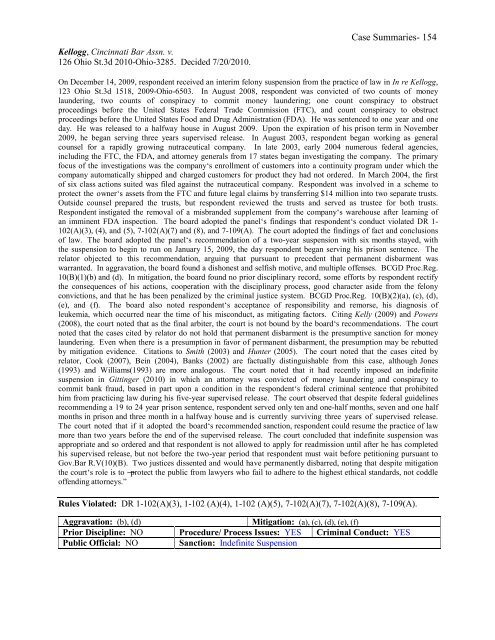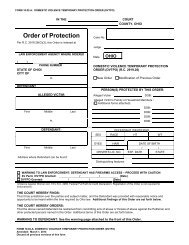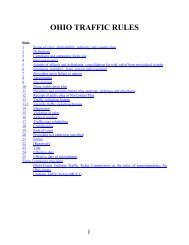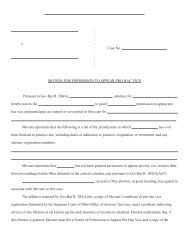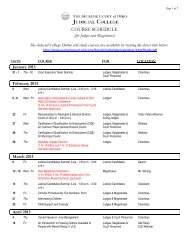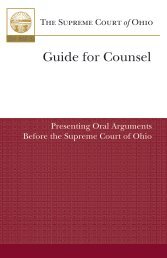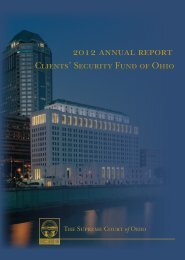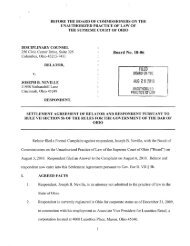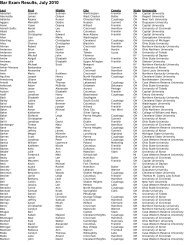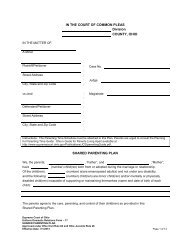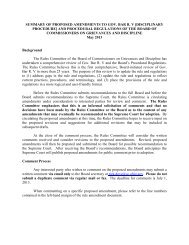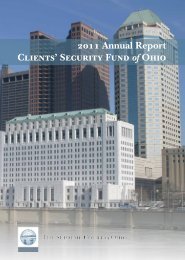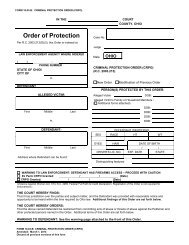disciplinary handbook: volume v - Supreme Court - State of Ohio
disciplinary handbook: volume v - Supreme Court - State of Ohio
disciplinary handbook: volume v - Supreme Court - State of Ohio
Create successful ePaper yourself
Turn your PDF publications into a flip-book with our unique Google optimized e-Paper software.
Kellogg, Cincinnati Bar Assn. v.126 <strong>Ohio</strong> St.3d 2010-<strong>Ohio</strong>-3285. Decided 7/20/2010.Case Summaries- 154On December 14, 2009, respondent received an interim felony suspension from the practice <strong>of</strong> law in In re Kellogg,123 <strong>Ohio</strong> St.3d 1518, 2009-<strong>Ohio</strong>-6503. In August 2008, respondent was convicted <strong>of</strong> two counts <strong>of</strong> moneylaundering, two counts <strong>of</strong> conspiracy to commit money laundering; one count conspiracy to obstructproceedings before the United <strong>State</strong>s Federal Trade Commission (FTC), and count conspiracy to obstructproceedings before the United <strong>State</strong>s Food and Drug Administration (FDA). He was sentenced to one year and oneday. He was released to a halfway house in August 2009. Upon the expiration <strong>of</strong> his prison term in November2009, he began serving three years supervised release. In August 2003, respondent began working as generalcounsel for a rapidly growing nutraceutical company. In late 2003, early 2004 numerous federal agencies,including the FTC, the FDA, and attorney generals from 17 states began investigating the company. The primaryfocus <strong>of</strong> the investigations was the company‘s enrollment <strong>of</strong> customers into a continuity program under which thecompany automatically shipped and charged customers for product they had not ordered. In March 2004, the first<strong>of</strong> six class actions suited was filed against the nutraceutical company. Respondent was involved in a scheme toprotect the owner‘s assets from the FTC and future legal claims by transferring $14 million into two separate trusts.Outside counsel prepared the trusts, but respondent reviewed the trusts and served as trustee for both trusts.Respondent instigated the removal <strong>of</strong> a misbranded supplement from the company‘s warehouse after learning <strong>of</strong>an imminent FDA inspection. The board adopted the panel‘s findings that respondent‘s conduct violated DR 1-102(A)(3), (4), and (5), 7-102(A)(7) and (8), and 7-109(A). The court adopted the findings <strong>of</strong> fact and conclusions<strong>of</strong> law. The board adopted the panel‘s recommendation <strong>of</strong> a two-year suspension with six months stayed, withthe suspension to begin to run on January 15, 2009, the day respondent began serving his prison sentence. Therelator objected to this recommendation, arguing that pursuant to precedent that permanent disbarment waswarranted. In aggravation, the board found a dishonest and selfish motive, and multiple <strong>of</strong>fenses. BCGD Proc.Reg.10(B)(1)(b) and (d). In mitigation, the board found no prior <strong>disciplinary</strong> record, some efforts by respondent rectifythe consequences <strong>of</strong> his actions, cooperation with the <strong>disciplinary</strong> process, good character aside from the felonyconvictions, and that he has been penalized by the criminal justice system. BCGD Proc.Reg. 10(B)(2)(a), (c), (d),(e), and (f). The board also noted respondent‘s acceptance <strong>of</strong> responsibility and remorse, his diagnosis <strong>of</strong>leukemia, which occurred near the time <strong>of</strong> his misconduct, as mitigating factors. Citing Kelly (2009) and Powers(2008), the court noted that as the final arbiter, the court is not bound by the board‘s recommendations. The courtnoted that the cases cited by relator do not hold that permanent disbarment is the presumptive sanction for moneylaundering. Even when there is a presumption in favor <strong>of</strong> permanent disbarment, the presumption may be rebuttedby mitigation evidence. Citations to Smith (2003) and Hunter (2005). The court noted that the cases cited byrelator, Cook (2007), Bein (2004), Banks (2002) are factually distinguishable from this case, although Jones(1993) and Williams(1993) are more analogous. The court noted that it had recently imposed an indefinitesuspension in Gittinger (2010) in which an attorney was convicted <strong>of</strong> money laundering and conspiracy tocommit bank fraud, based in part upon a condition in the respondent‘s federal criminal sentence that prohibitedhim from practicing law during his five-year supervised release. The court observed that despite federal guidelinesrecommending a 19 to 24 year prison sentence, respondent served only ten and one-half months, seven and one halfmonths in prison and three month in a halfway house and is currently surviving three years <strong>of</strong> supervised release.The court noted that if it adopted the board‘s recommended sanction, respondent could resume the practice <strong>of</strong> lawmore than two years before the end <strong>of</strong> the supervised release. The court concluded that indefinite suspension wasappropriate and so ordered and that respondent is not allowed to apply for readmission until after he has completedhis supervised release, but not before the two-year period that respondent must wait before petitioning pursuant toGov.Bar R.V(10)(B). Two justices dissented and would have permanently disbarred, noting that despite mitigationthe court‘s role is to ―protect the public from lawyers who fail to adhere to the highest ethical standards, not coddle<strong>of</strong>fending attorneys.‖Rules Violated: DR 1-102(A)(3), 1-102 (A)(4), 1-102 (A)(5), 7-102(A)(7), 7-102(A)(8), 7-109(A).Aggravation: (b), (d)Mitigation: (a), (c), (d), (e), (f)Prior Discipline: NO Procedure/ Process Issues: YES Criminal Conduct: YESPublic Official: NO Sanction: Indefinite Suspension


